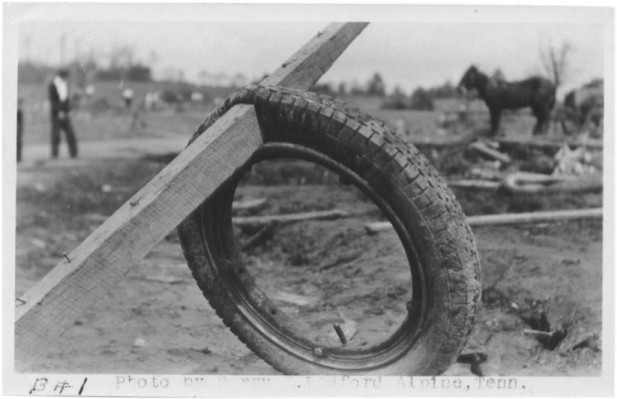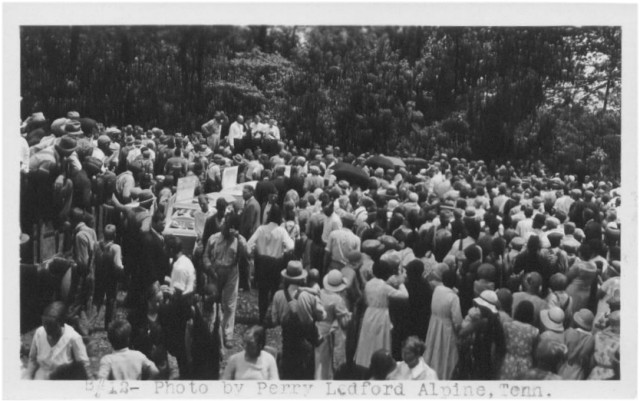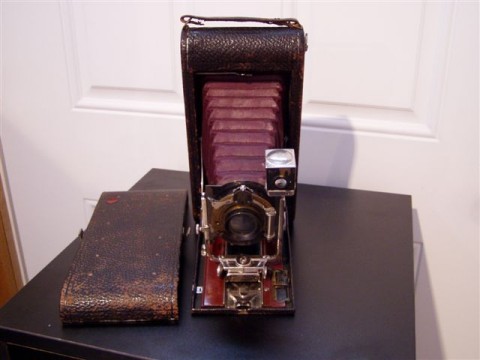|
1933 Tornado |
On Friday, May 12, 1933, the front page of
The Livingston Enterprise reported what was called "the worst
disaster of this section." A staff correspondent, Samuel K. Neal,
described the scene at Bethsaida, Tennessee, following a tornado that
struck that area. Here are parts of Mr. Nealís story:
"Bethsaida, Tenn., May 10 - This little mountain settlement bore the
brunt of Tuesday nightís storm when it climaxed into a tornado early
Wednesday morning leaving more than a score dead and as many or more
injured. More than twenty persons were reported injured at Smithís store
here, where emergency relief was started Wednesday. Doctors from
Livingston, Cookeville, and other places were giving first aid. The
bodies of sixteen of the dead were brought to Livingston where they were
prepared for burial. Four members of one family will be buried at the
home site. The tornado struck with terrible suddenness. Beginning at
Eagle Creek, northwest of Bethsaida, the twister moved in a zig-zag line
three-quarters of a mile wide, spent its fury here, and ended near West
Fork, a distance of about eleven miles from its beginning. In its wake
it left the worst destruction this section of Tennessee has ever seen.
Houses were torn down, barns with their contents, including farm
machinery, were swept away as if they had been match boxes. A farmerís
binder was blown from his barn to a field 500 yards distant, and was
left a worthless scrap of twisted iron. A new automobile was swept along
for hundreds of feet and left a wrecked mass. The horror of the storm
was emphasized by the broken, twisted, torn bodies lying in a morgue at
the Blount Funeral Home in Livingston. The most touching scene of all
was the family of Eunice Cole, man, wife, and seven children, ranging in
age from two to fourteen. All were killed, probably in their sleep. They
were found near their home site in their night clothes, their bodies
covered with grime and scraps of debris. More horrible was the manner in
which some of the bodies were found, their bones broken into an
incongruous mass, and on two, parts of the heads were missing."
|
|

A tire
torn from a car owned by Mrs. George Reeser had been pierced by a 2X4
timber during the storm. Mrs. Reeser's daughter and son-in-law were among
the casualties of the devastating tornado. |
| "The tornado
brought its share of freaks. A square of floor linoleum was found driven
into a tree; a two-by-four plank was driven completely through an
automobile tire; a millet straw was found driven into a fruit tree. But
most peculiar of all was at the home of Will Crawford, whose house was
blown away, as were all his outhouses and his barn. In his chicken house
two hens were setting, and they were found this morning complacently
perched in their nests under a pile of debris, busily hatching their eggs,
oblivious to the destruction surrounding them."
An additional story included in the May 19, 1933 issue of The
Livingston Enterprise tells how a young couple, Ray Reagan, age 23,
and Epsie King, age 22, who had plans to be married were among the victims
of the tornado. The article written about this couple told how the two had
been sweethearts since childhood and had plans to be married soon. Then
came the storm and each life was snuffed out. They were buried side by
side at the Smith Cemetery.
|
|

A quartet
sings as the crowd of friends and relatives walk by the caskets to pay
their last token of respect and to view the remains of the Una Cole
family.
|
Others who lost their lives in the tornado included the Una Cole family,
husband and wife, and seven children. Mr. Cole was 40 years old, his wife
was only 35. Their childrenís names were: Carrie, age 22, Magnus, age 15;
Edith age 9; Marian age 8; Ruth Dean, age 5; Anna, age 3, and Marse, age
1. Funeral services were conducted on the Saturday following the tornado
at the Red Hill Cemetery with Rev. John Coleman and Rev. H.C. Geiger in
charge. Masonic rites were included for Mr. Cole at the grave site by the
Eagle Creek Lodge of which he was a member. Mr. Cole was a veteran and was
wounded twice while in action in France. The entire family of nine were
buried in one grave. According to the newspaper report, this is the
largest number ever to be buried in a single grave in this section.
"Others who lost their lives in the tornado were: Mr. and Mrs. Boss Lacey,
ages 40 and 31; Mrs. Mary Reeser, age 68 (mother-in-law of Ed Hopkins); Ed
Hopkins, age 35 and daughter, Barbara Hopkins, age 6; Miller Allred, age
60; Hughey Beatty, age 35; Hershel Phillips, age 40; and Mrs. Ambrose
King, age 45, mother of Epsie King."
"The hills and valleys of the area on the day the storm struck were
described as being clothed in a thick haze, and during the early part of
the evening and until late Tuesday night, the air was stuffy, with a
flashing electrical storm and a high wind predicting a heavy rain. The
rain in the tornado area was of flood proportions."
To document the results of this devastating tornado, Perry Ledford was
commissioned to photograph the storm damaged area. I am including two of
his photographs with this story. Mr. Ledford was the son of Nanie Copeland
Ledford and husband Elmer Ledford who lived in the Oak Grove community
between Livingston and Alpine. Nanie Copeland and my Grandpa Elza Copeland
were brother and sister. Perry Ledford was the only child of Nanie and
Elmer Ledford. The camera he used was a Model B-4 Eastern Kodak. That
camera, along with additional pictures, has been donated to the Overton
County Museum by Perry Ledfordís daughter, Theora Ledford Stumpf of the
Rickman community. A display of the Ledford photographs and camera can be
seen at the museum. Mr. Ledford left detailed explanations about each one
of the picture taken. One of the photographs describes "logs and wreckage
from under which was taken the body of Mrs. Una Cole and that of her small
baby to whom she had clung even until death had relaxed her grip."
One of the newspaper articles summed up the spirit of those made it
through the storm: "In spite of living through such a catastrophe, those
who survived were described as clinging to something that carried them on
against bitter odds. They cannot be cheerful, but there is no whining
among them. Doubtless such destruction has brought a misery to their
hearts, but they are stooping, with worn out tools, to build again, with
something of the quiet strength which must have been inherited from their
native hills."
|
|

Perry
Ledford's Eastern Kodak Model B-4 camera is on display along with his
photographs taken following the tornado that struck the area around the
Bethsaida community of Overton County, TN in 1933. |


